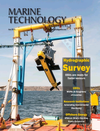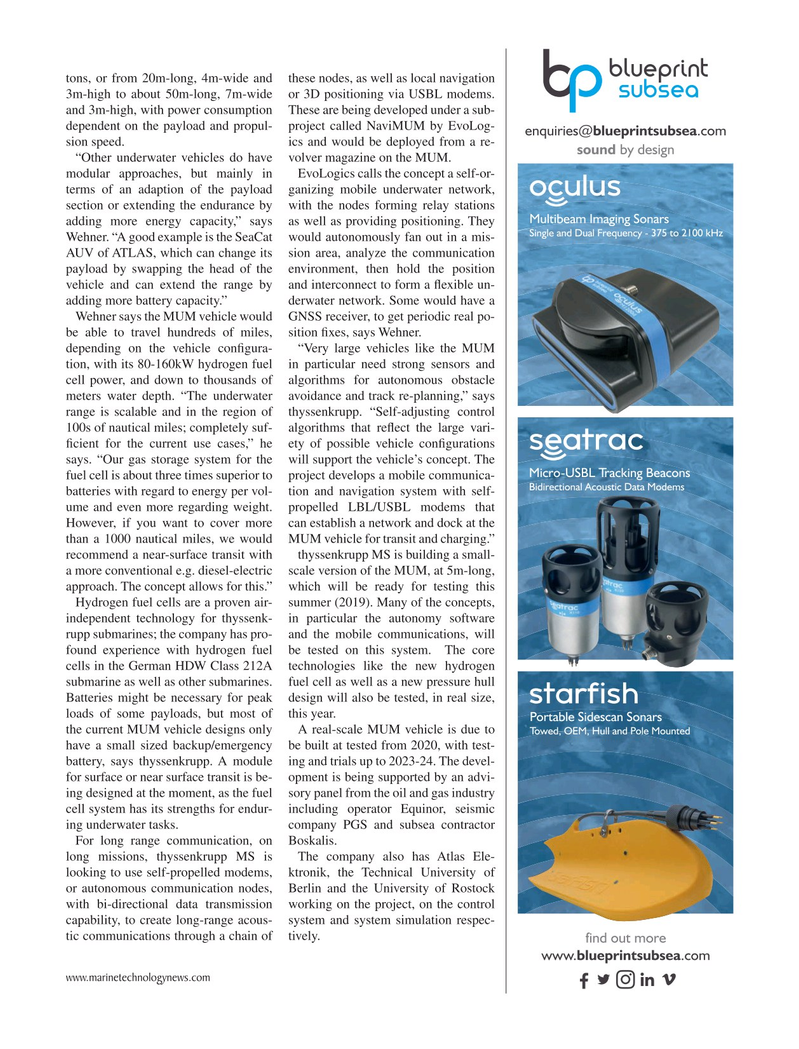
Page 25: of Marine Technology Magazine (June 2019)
Hydrographic Survey: Single & Multibeam Sonar
Read this page in Pdf, Flash or Html5 edition of June 2019 Marine Technology Magazine
tons, or from 20m-long, 4m-wide and these nodes, as well as local navigation 3m-high to about 50m-long, 7m-wide or 3D positioning via USBL modems. and 3m-high, with power consumption These are being developed under a sub- dependent on the payload and propul- project called NaviMUM by EvoLog-
HQTXLULHV#EOXHSULQWVXEVHDFRP sion speed. ics and would be deployed from a re-
VRXQGE\GHVLJQ “Other underwater vehicles do have volver magazine on the MUM. modular approaches, but mainly in EvoLogics calls the concept a self-or- terms of an adaption of the payload ganizing mobile underwater network, section or extending the endurance by with the nodes forming relay stations 0XOWLEHDP,PDJLQJ6RQDUV adding more energy capacity,” says as well as providing positioning. They 6LQJOHDQG'XDO)UHTXHQF\WRN+]
Wehner. “A good example is the SeaCat would autonomously fan out in a mis-
AUV of ATLAS, which can change its sion area, analyze the communication payload by swapping the head of the environment, then hold the position vehicle and can extend the range by and interconnect to form a ? exible un- adding more battery capacity.” derwater network. Some would have a
Wehner says the MUM vehicle would GNSS receiver, to get periodic real po- be able to travel hundreds of miles, sition ? xes, says Wehner. depending on the vehicle con? gura- “Very large vehicles like the MUM tion, with its 80-160kW hydrogen fuel in particular need strong sensors and cell power, and down to thousands of algorithms for autonomous obstacle meters water depth. “The underwater avoidance and track re-planning,” says range is scalable and in the region of thyssenkrupp. “Self-adjusting control 100s of nautical miles; completely suf- algorithms that re? ect the large vari- ? cient for the current use cases,” he ety of possible vehicle con? gurations says. “Our gas storage system for the will support the vehicle’s concept. The 0LFUR86%/7UDFNLQJ%HDFRQV fuel cell is about three times superior to project develops a mobile communica- %LGLUHFWLRQDO$FRXVWLF'DWD0RGHPV batteries with regard to energy per vol- tion and navigation system with self- ume and even more regarding weight. propelled LBL/USBL modems that
However, if you want to cover more can establish a network and dock at the than a 1000 nautical miles, we would MUM vehicle for transit and charging.” recommend a near-surface transit with thyssenkrupp MS is building a small- a more conventional e.g. diesel-electric scale version of the MUM, at 5m-long, approach. The concept allows for this.” which will be ready for testing this
Hydrogen fuel cells are a proven air- summer (2019). Many of the concepts, independent technology for thyssenk- in particular the autonomy software rupp submarines; the company has pro- and the mobile communications, will found experience with hydrogen fuel be tested on this system. The core cells in the German HDW Class 212A technologies like the new hydrogen submarine as well as other submarines. fuel cell as well as a new pressure hull
Batteries might be necessary for peak design will also be tested, in real size, loads of some payloads, but most of this year.
3RUWDEOH6LGHVFDQ6RQDUV the current MUM vehicle designs only A real-scale MUM vehicle is due to 7RZHG2(0+XOODQG3ROH0RXQWHG have a small sized backup/emergency be built at tested from 2020, with test- battery, says thyssenkrupp. A module ing and trials up to 2023-24. The devel- for surface or near surface transit is be- opment is being supported by an advi- ing designed at the moment, as the fuel sory panel from the oil and gas industry cell system has its strengths for endur- including operator Equinor, seismic ing underwater tasks. company PGS and subsea contractor
For long range communication, on Boskalis. long missions, thyssenkrupp MS is The company also has Atlas Ele- looking to use self-propelled modems, ktronik, the Technical University of or autonomous communication nodes, Berlin and the University of Rostock with bi-directional data transmission working on the project, on the control capability, to create long-range acous- system and system simulation respec- tic communications through a chain of tively.
ILQGRXWPRUH
ZZZEOXHSULQWVXEVHDFRP www.marinetechnologynews.com
MTR #5 (18-33).indd 25 5/28/2019 4:50:22 PM

 24
24

 26
26
